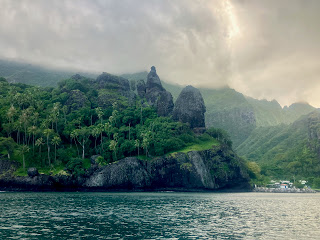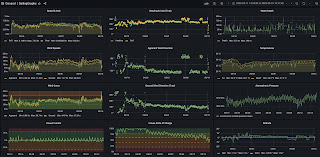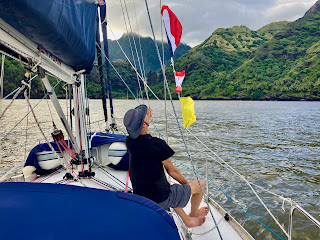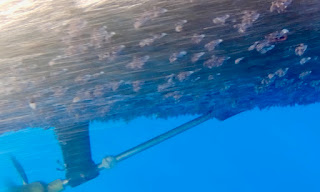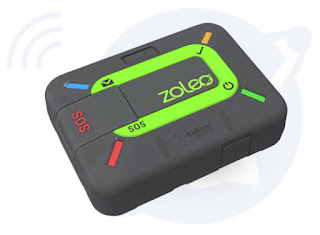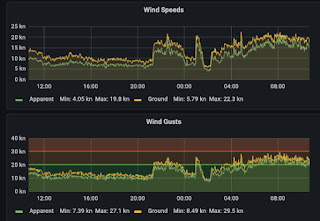Hi everyone,Here is the summary of our passage from Panama to the Marquesas in French Polynesia. It was a 4000nm passage of two distinct parts - to the trades and then in the trades.
 |
| Zen Again in the Bay of Virgins, Fatu Hiva |
Here are several views of our track…
 |
| Panama to Marquesas |
 |
| Halfway home! |
 |
| Closing the loop |
Here are the vital stats for the passage…
• Distances/Speeds
• Route Distance = 3900 nm (S of Galapagos)
• Logged Distance = 3903 nm (under-reading)
• GPS Distance = 4337 nm
• Duration = 34 days 20 hours
• Average speed over ground = 5.2 kt
• Average day's run = ~125 nm
• Best day's run = 144 nm over ground, 140 nm by log
• Minimum boat speed = 3 kt
• Maximum boat speed = 8 kt over ground, 7 kt by log
• Weather
• Minimum wind speed = 1 kt
• Average wind speed = 15 knots
• Maximum wind speed = 23 with gusts to 39
• Apparent wind angle range = 20 to 150
• Seas up to 2m
• Swell up to 3m
• Many squalls, most of which missed us and were mostly mild (up to 30 kt)
• Engine
• Total = 123 hours (all except last 3 hours between Panama and the trades)
• Driving = 123 hours
• Charging = 0 hours
• Consumed 200 litres of 280 aboard (65%), burning 1.5 litres/hours
• Water
• Consumed 180 litres of 280 aboard (71%), or 2.85 litres/person/day
• Failures
• Our Gen2 Starlink became unreliable when its GPS failed (Starlink have committed to replace)
• Computer keyboard died (replaced with an alternate)
• Head pump had to be removed, serviced and replaced enroute
• Chafe on WindPilot control line due to rubbing against s/s tube - freshened the nip to fix
• Stars
• The boat!
• WindPilot vane gear (in the trades)
• Pelagic autopilot (to the trades)
• Tides Marine SailTrack (made reefing sooo much easier)
• Mac Mini / SignalK based NavCom system
• Icom HF/SSB radio
• PredictWind Offshore app (over Starlink) for GRIBs, routing and tracking friends
• The Chef
Here are the usual graphs for the passage...
And here's how our electrical system coped. During the first week we were motoring regularly so the batteries were in good shape. In the trades they gradually trended down, mainly due to the long Starlink startup times after its GPS died.
Getting to the trades was tedious. We had light SW winds but lots of squalls. Most of the squalls missed us but they created a messy seaway which made sailing impossible. Also impossible was motoring directly into the chop. So we motor-sailed with the main strapped in tight. This worked quite well. Currents were variable in this phase and often contrary.
Once in the trades we were very lucky with squalls again missing us more often than not. When we did get one it usually held no more than 25 knots of wind with sometimes heavy rain, and it usually passed on rapidly. Mostly the trades were nice sailing under our trisail sized double-reefed main and yankee furled to suite the conditions. Initially in the trades we could lay the route while broad reaching since the winds were SE. Eventually the winds became more ESE and we had to gybe to and fro, reducing our VMG. Nevertheless we beat some much larger boats who had departed with us to the islands. Currents were favourable in this phase, often over 1 knot.

Since arriving we've been gradually cleaning Zen Again. We accumulated many gooseneck barnacles below and around the waterline. Interestingly they were eaten by the fish in Fatu Hiva. Sadly the fish left the calcium disks behind. We had our worst ever fouling of the topsides with weed and baked-on green muck. The latter is proving difficult to remove but we're making progress.
Overall this was our longest duration passage by about 3 days, second to our 2016 passage from St Helena to St Lucia (
passage summary here). Once we reached the trades it was a really good sail with minimal drama. It was nice to be sailing in loose company with our EBBYC pals plus several OCC boats.
Trust all's well where you are!











